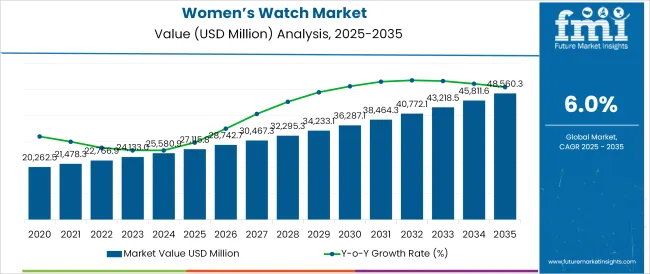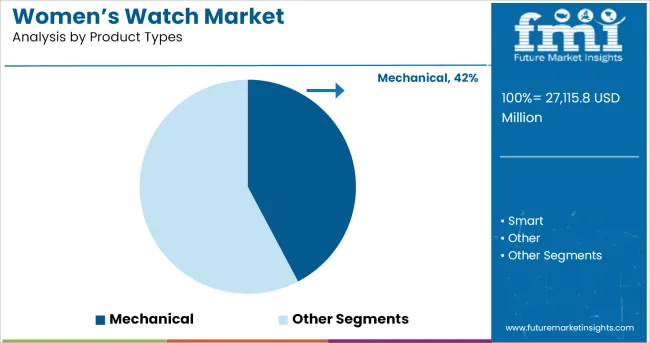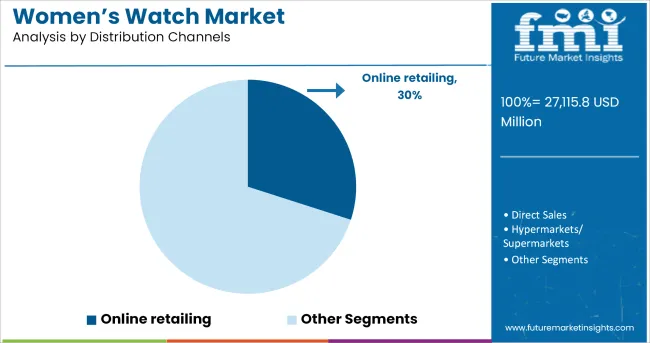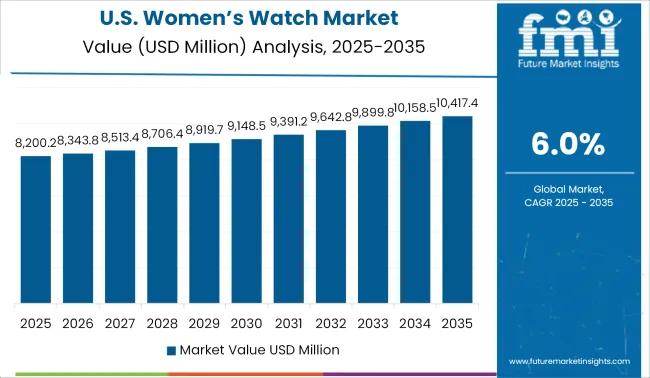The Women’s Watch Market is estimated to be valued at USD 27,115.8 million in 2025 and is projected to reach USD 48,560.3 million by 2035, registering a compound annual growth rate (CAGR) of 6.0% over the forecast period.

The women’s watch market is witnessing steady expansion, driven by the interplay of traditional craftsmanship, evolving fashion sensibilities, and growing digital influence in consumer purchasing behaviour. As luxury and fashion brands increasingly cater to women with exclusive collections, mechanical timepieces are gaining popularity for their sophistication and heritage appeal.
Simultaneously, mid-priced categories are capturing growing interest from aspirational buyers seeking quality without luxury-level pricing. Advances in materials, slimmer movements, and design personalization have made mechanical watches more wearable and desirable for daily and occasion use. The shift toward Omni channel strategies is especially evident in the growth of online retail, where curated digital storefronts, influencer campaigns, and AR enabled try-on features are elevating the virtual shopping experience.
As younger demographics begin to value timepieces not just as utility tools but as lifestyle and fashion statements, the market is expected to benefit from growing demand across both premium and accessible segments, with strong digital momentum driving future channel innovation.
The market is segmented by Product Types, Price, and Distribution Channels and region. By Product Types, the market is divided into Mechanical, Smart, and Other. In terms of Price, the market is classified into USD 200 - USD 400, USD 400 - USD 600, USD 600 - USD 800, USD 800 & above, and Under USD 200. Based on Distribution Channels, the market is segmented into Online retailing, Direct Sales, Hypermarkets/ Supermarkets, Specialty Stores, and Others. Regionally, the market is classified into North America, Latin America, Western Europe, Eastern Europe, Balkan & Baltic Countries, Russia & Belarus, Central Asia, East Asia, South Asia & Pacific, and the Middle East & Africa.

Mechanical watches are projected to account for 42.3% of the total women’s watch market revenue in 2025, positioning them as the leading product type. This segment’s strength is underpinned by consumer preference for craftsmanship, tradition, and the mechanical intricacies that represent heritage and exclusivity.
Mechanical movements, especially those with skeleton designs or visible complications, have become symbols of status and style among women seeking timeless elegance over digital functionality. Watchmakers have responded by designing lighter, thinner mechanical watches tailored to women's wrists, without compromising mechanical complexity.
Additionally, limited-edition collections and luxury collaborations have contributed to a surge in demand. The segment’s sustained dominance is further reinforced by its appeal in the gifting category and its association with long-term value, uniqueness, and emotional investment factors that digital alternatives typically do not offer.

The USD 200-USD 400 price bracket is expected to capture 28.0% of the market share in 2025, emerging as the dominant pricing segment. This mid-range category has seen increased traction due to its ability to offer a balance of quality, brand recognition, and affordability, particularly for fashion-forward yet budget-conscious consumers.
Brands positioned in this range are focusing on offering premium aesthetics such as sapphire glass, stainless steel cases, and automatic movements at accessible prices. Consumers within this segment often seek everyday luxury without a high-end price tag, making it a volume-driven growth area.
The rise of social commerce, influencer marketing, and loyalty programs has enabled brands to effectively reach and convert consumers in this price segment, sustaining its prominence as the preferred entry point for aspirational buyers stepping into the watch category.

Online retailing is projected to hold 30.0% of the total market revenue by 2025 within the distribution channel segment, making it the leading channel. The dominance of this segment has been propelled by the convenience, accessibility, and product variety offered through digital platforms.
The ability to browse multiple brands, styles, and price points in real time has attracted a wide demographic, especially millennials and Gen Z shoppers. Enhanced digital features such as virtual try-on, video reviews, and AI-based recommendations have improved user engagement and reduced purchase hesitation.
E-commerce platforms and direct-to-consumer brand websites have capitalized on faster logistics, seamless returns, and curated experiences to drive conversions. Additionally, the online channel has supported global reach for niche and independent brands that may not have a strong offline presence. As digital touchpoints become central to the luxury and fashion shopping journey, online retailing is expected to remain the primary growth engine for women’s watches.
The rise in the number of working women has accelerated the sales of women’s watches across the globe. Also, the increase in innovative and customized designs is anticipated to drive the market in the next few years.
Usage of women watch is no longer limited to offices and functions. Women wear these watches as a fashion statement. Moreover, watches are gifted on various occasions or events like birthdays and anniversaries. This consumption behaviour is expected to positively impact market growth.
Furthermore, the trend of smartwatches among women nowadays drives the women’s watch market. Many prominent key players in the women’s watch industry include Withings Steel, Fitbit Versa Smart Watch, are investing in the research and development sector for introducing smartwatches with a more efficient battery, excellent performance and advance features like connect with GPS, receive calls and texts.
Many players are principally engaged in introducing varieties of attractive designs at affordable prices. This innovation and new launch gives the opportunity to the customers to choose the watch according to their budget and also encourage other players to invest in this sector which drives the market during the forecast period.
Growing awareness regarding health among women all around the globe has resulted in the raised women’s spending on health care gadgets, which has further lead the market of smartwatches. This smartwatch has multiple features like walk tracking, analyze heartbeat rate, connect with smartphones and other advanced applications which has raised the sales of women’s smartwatches.
For instance, Fossile launched Gen 4 Venture, an impressive watch for women. Apart from good looks, this watch offers extra features to the customers like recording the activity done by the women as well as the Calories burned while doing physical activity. These watches can be used as a sleep monitoring device. All these advanced features offered by manufacturers are anticipated to drive the demand for jewellery over the forecast period.

The ladies of the United States and Canada are technologically outstanding and have a higher mission for strong advancements with a vision to make life simpler. Young ladies in the region are more aware of smart technology which has increased the demand for smartwatches in the region.
Moreover, for expanding the product portfolio of smartwatches in the region, many prominent players like Zelos, Shreve & Co., VANNA and Fossil continuously launching smartwatches at different price ranges.
For instance, Fossil launched a smartwatch that keeps the record of the user physical activity and also monitors the heartbeat and the blood pressure of the person. This helps the player to strengthen their presence in the regional market.

According to the report of BMI in 2020, 37% to 58% women in Italy and Croatia suffer from obesity, which is increasing the demand for health gadgets like fitness band/watch in the European market.
The growing popularity of fitness watches among women, which also helps in recording body activity like cycling, swimming laps, daily steps, sleeping pattern, pulse rate and blood pressure. These advanced features encourage women to buy a smartwatch to accessing their regular activates including calories intake. Furthermore, the rising income of people enabling them to buy such smart products which also meet their requirements and desires.
Moreover, with an aim of business expansion and growing business portfolio, players are creating a partnership with the regional distributors to get feedback from the customers and fulfil the demands of the customers. This helps the players to generate more revenue.

Some of the leading manufacturers and suppliers of ladies watches include
The report is a compilation of first-hand information, qualitative and quantitative assessment by industry analysts, inputs from industry experts and industry participants across the value chain. The report provides in-depth analysis of parent market trends, macro-economic indicators and governing factors along with market attractiveness as per segments. The report also maps the qualitative impact of various market factors on market segments and geographies.
The global women’s watch market is estimated to be valued at USD 27,115.8 million in 2025.
The market size for the women’s watch market is projected to reach USD 48,560.3 million by 2035.
The women’s watch market is expected to grow at a 6.0% CAGR between 2025 and 2035.
The key product types in women’s watch market are mechanical, smart and other.
In terms of price, USD 200 - USD 400 segment to command 28.0% share in the women’s watch market in 2025.






Full Research Suite comprises of:
Market outlook & trends analysis
Interviews & case studies
Strategic recommendations
Vendor profiles & capabilities analysis
5-year forecasts
8 regions and 60+ country-level data splits
Market segment data splits
12 months of continuous data updates
DELIVERED AS:
PDF EXCEL ONLINE
Watch Case Market Trends & Growth Forecast 2024-2034
Smartwatch Chips Market Size and Share Forecast Outlook 2025 to 2035
Kids Watch Market
Smart Watch Market Size and Share Forecast Outlook 2025 to 2035
Wrist Watch Packaging Market Size and Share Forecast Outlook 2025 to 2035
Breaking Down Market Share in the Wrist Watch Packaging Industry
Men's Watch Market

Thank you!
You will receive an email from our Business Development Manager. Please be sure to check your SPAM/JUNK folder too.
Chat With
MaRIA